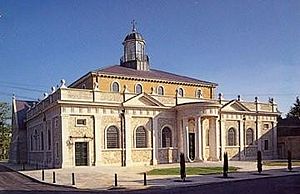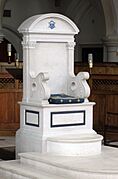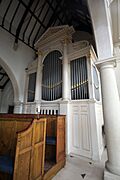Brentwood Cathedral facts for kids
Quick facts for kids Brentwood Cathedral |
|
|---|---|
| The Cathedral of St Mary and St Helen | |
 |
|
| 51°37′10″N 0°18′23″E / 51.6194°N 0.3063°E | |
| Location | Brentwood, Essex |
| Country | England |
| Denomination | Catholic Church |
| Website | Brentwood Cathedral Brentwood Cathedral Music |
| History | |
| Consecrated | 1991 |
| Architecture | |
| Previous cathedrals | Enlarged by Quinlan Terry in 1991 |
| Architect(s) | Quinlan Terry |
| Architectural type | New Classical |
| Style | Gothic Revival, English Baroque |
| Years built | 1989–1991 |
| Specifications | |
| Capacity | 1600 |
| Administration | |
| Archdiocese | Westminster |
| Diocese | Brentwood (since 1914) |
| Province | Westminster |
Brentwood Cathedral, officially known as The Cathedral of St Mary and St Helen, is a special Catholic church in Brentwood, Essex, England. It's the main church for the Diocese of Brentwood, which means it's where the local bishop has his official seat.
Contents
History of Brentwood Cathedral
Brentwood Cathedral started as a regular parish church in 1861. It was built in a Gothic style, which means it looked like older medieval churches. This church became a cathedral in 1917.
Between 1989 and 1991, the church was made much bigger. A famous architect named Quinlan Terry designed the new parts in a classical style, similar to old Italian buildings. This new section replaced an earlier addition from 1974.
The new Brentwood Cathedral was officially opened by Cardinal Hume on May 31, 1991. The money for this big project came from people who wanted to remain anonymous. In 2022, the cathedral was given a special status as a Grade II* Listed building, recognizing its important history and architecture.
Architecture and Design
The architect, Quinlan Terry, was inspired by early Italian Renaissance buildings and the English Baroque style of Christopher Wren. This design was chosen to fit in with the town and to create a bright, open space for church services. The cathedral was designed with a square shape, focusing on the main altar in the middle.
Building the Cathedral
Work on the new parts began in 1989 and finished two years later. The north side of the building has nine sections, each separated by Doric columns. A large half-circle entrance, similar to one at St Paul's Cathedral, breaks up this side.
The upper part of the building, called the clerestory, is made of traditional handmade bricks. Above this is an eight-sided dome, which is the highest point both inside and outside the cathedral.
Mixing Old and New Styles
A special decision was made to keep part of the original 1861 Gothic church. The east side of the cathedral shows both the old and new styles side by side. They are connected by the size of the 1991 building and the use of similar materials like ragstone and Welsh slate roof tiles.
Inside the Cathedral
Inside, you can see different types of classical columns and designs. The main columns are Doric, and there are also Tuscan arches and Ionic columns around the windows.
The inside of the cathedral feels calm and simple, but the ceiling is very detailed. It has patterns picked out in gold. All the round-topped windows are clear, letting in lots of light.
Because of its clear windows on all sides, the cathedral is filled with light throughout the day. The white walls and stone floor make the space feel bright and uplifting. The cathedral is lit by brass chandeliers, one of which used to be in a church in Epping, Essex.
The cross used in processions is a copy of an old medieval design. The Bishop's special chair, called a cathedra, shows his role as the leader of the diocese. It was made in Italy from special stone.
Special Consecration crosses are carved into the stone columns. These crosses were anointed, like the altar, to show that the whole building is dedicated to God. Candles are lit in front of these crosses on the day the cathedral celebrates its dedication. In one part of the church, there are two rooms for confession. Nearby, there is a crucifix that used to be in a church in Stock, Essex.
Around the arches, there are terracotta circles showing the fifteen Stations of the Cross. These were made by Raphael Maklouf, a famous sculptor who designed the Queen's head on Commonwealth coins for many years.
Music at the Cathedral
Music at Brentwood Cathedral is managed by Brentwood Cathedral Music. The Master of Music, Andrew Wright, started the cathedral choir in 1984. The choir has grown a lot since then. It now includes boy and girl choristers, as well as adult singers.
The choir has made recordings and performed on BBC Radio. They have also toured in several European countries. The choir works with the RSCM (Royal School of Church Music) and has musical connections with the Diocese of Chelmsford.
The cathedral's organ was a gift from the Diocese of Chelmsford. It came from an old Anglican church in Colchester. The organ was originally built in 1889 and was fully rebuilt and restored for the cathedral.
See also
 In Spanish: Catedral de Santa María y Santa Elena (Brentwood) para niños
In Spanish: Catedral de Santa María y Santa Elena (Brentwood) para niños
- Bishop of Brentwood
- Bishop Thomas McMahon
- Bishop George Andrew Beck
- Quinlan Terry





